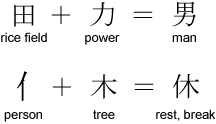Japanese Kanji
Japanese Kanji came from China in the 5th to the 6th centuries.
Then later Hiragana and Katakana evolved to represent "readings" in Japanese.
There are about 15,000 characters used in modern Japanese, out of over 50,000 that exists.
However most of them are used in names of places and people, or used as technical terms in historical or medical books.
There are not too many characters used in general documents.
Joyo Kanji
In 1981, the Ministry of Education, Science, Sports and Culture (the former Ministry of Education) designated 1,945 Kanji characters for everyday use in order to standardize the Japanese writing system. These Kanji characters are called Joyo Kanji.
In 2010, Joyo Kanji was revised. 196 Kanji characters were added and 5 Kanjis were removed. The current Joyo Kanji consists of 2,136 Kanji characters.
Japanese sentences in general terms are composed by using these standard Kanji characters. Newspapers and business documents are generally written following Joyo Kanji, therefore Joyo Kanji is the standard when foreigners learn Kanji.
However, the list of the standard Kanji characters includes some that are hardly used in everyday writing - 畝, 帥 and 璽 are good examples.
On the other hand, some characters such as 嘘, 噂 and 濡 are used frequently everyday despite the fact that they do not appear on the Ministry's list.
In other words Joyo Kanji is only a standard and ordinary Japanese people do not follow it strictly in everyday writing.
On reading and Kun reading
Each Japanese Kanji usually has at least two readings, Japanese origin reading and Chinese origin reading. Japanese origin reading is called Kun Yomi and Chinese origin reading is called On Yomi.
A Kanji is used alone as a word, or is used with other Kanji as a Kanji compound which is called Jukugo. When a single Kanji is used as a word in a sentence, it is usually read in Kun Yomi. When Kanji are used together as a compound, it is usually read in On Yomi.
Kun Yomi is written in Hiragana and On Yomi is written in Katakana in our material.
 |
Kun Yomi |  |
 |
to eat |
| On Yomi |  |
 |
food, foodstuffs |
Forms of Kanji --- Bushu (Radical)
Kanji represent forms of something or situation and each of them represent meaning.

Above Kanji are clear examples however, many Kanji require some explanation to understand why they are in such forms.
Most Kanji consist of several parts. Such parts are called Bushu (Radical).
Some independent Kanji make appearance as Bushu of other Kanji, but in most cases Bushu appear only as parts.

First example 男, both 田 and 力 are individual Kanji on its own. They are combined to form another Kanji 男.
Next example 休,  is a radical representing 人 which means "person". It is not a character on its own. 休 represents a situation where a person rests under a tree.
is a radical representing 人 which means "person". It is not a character on its own. 休 represents a situation where a person rests under a tree.
There are over 200 radicals. Memorizing all will be difficult. We have listed 35 important radicals for your reference.
Important Bushu (Radical)
Stroke order
Stroke order for Kanji writing is called Kakijun. It is basically similar to Hiragana and Katakana writings.
Kakijun for Level 1 and Level 2 Kanji are in 2001.Kanji.Odyssey.
Number strokes are called Kakusu.
 |
2 Kaku (2 strokes) |
 |
4 Kaku (4 strokes) |


 Examples (Kanji numbers are from 2001.Kanji.Odyssey)
Examples (Kanji numbers are from 2001.Kanji.Odyssey)






































































